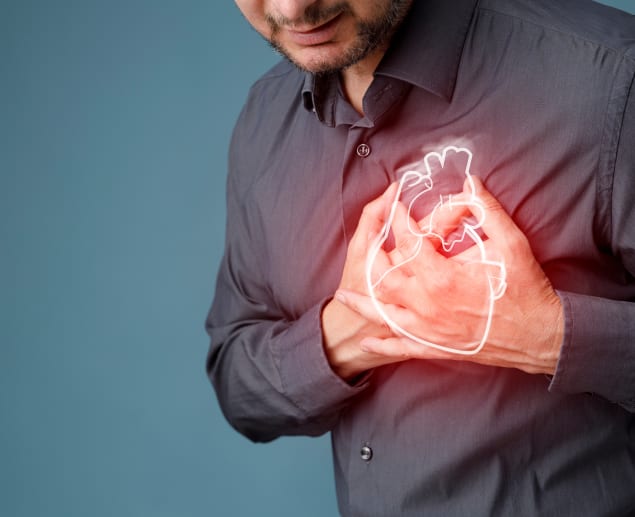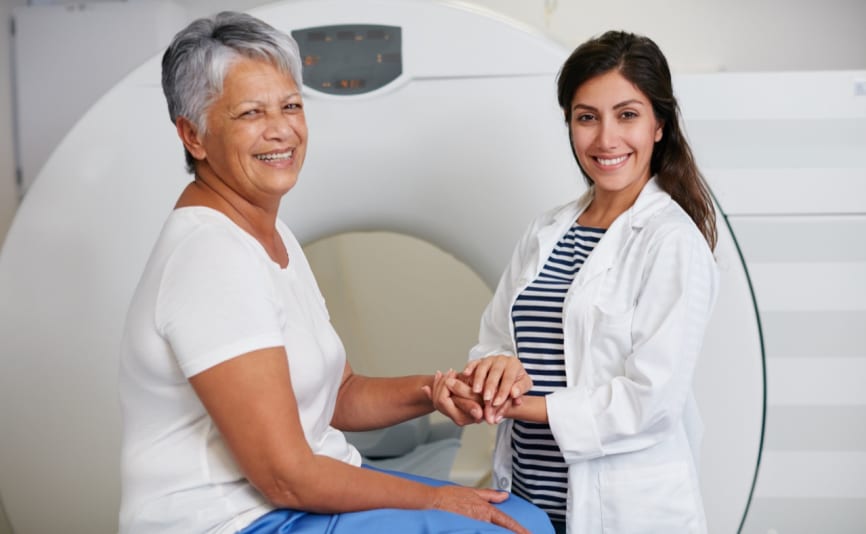If you're experiencing symptoms of coronary artery disease or have concerns about potential narrowing, blockages, or other issues within your heart's blood vessels, a CT coronary angiogram could provide the crucial insights you need.
This advanced imaging technique offers a detailed view of your coronary arteries, helping to diagnose and assess conditions that could impact your heart health.
In this guide, we'll explore what an angiogram of the heart entails, how a CT coronary angiogram is performed, why your doctor might recommend you have one and any potential risks and side effects you should be aware of before undergoing the procedure.
What is a coronary angiogram?
A coronary angiogram is an imaging test clinicians use to examine the heart's blood vessels. This procedure, often called a cardiac angiogram or heart angiogram, involves inserting a catheter, usually through an artery in your groin or wrist, which is then threaded up to the coronary arteries.
A contrast dye is injected through the catheter, and X-ray images are taken to show the blood flow and detect any blockages or narrowing in the arteries.
A CT angiogram of the heart is a more advanced, non-invasive version of this test without catheter insertion. Instead, the contrast dye is injected into a vein in your arm. CT coronary angiogram uses computed tomography (CT) technology to create detailed, three-dimensional images of the heart's blood vessels, providing a detailed picture of your coronary artery health.
How serious is an angiogram, and when do I need one?
The seriousness of the procedure depends on your individual health situation and why your clinician recommends that you have one.
Angiograms are common procedures in patients with symptoms that may be related to the heart.
However, problems with blood vessels in your heart can be serious and can even lead to life-threatening conditions. Your doctor may recommend that you have an angiogram if:
-
You have signs of coronary heart disease, such as chest pain (angina) or shortness of breath
-
The results of other tests, such as an electrocardiogram (ECG), suggest you might have coronary heart disease
-
You’ve had a heart attack, and doctors want a closer look at your heart to see if there are any blockages
-
You have high-risk factors for developing coronary heart disease (for example, if you smoke or have high cholesterol) and your doctor wants to assess your heart health.
-
You’re due to have surgery, and your doctor wants to take a closer look at the heart before the procedure.
CT coronary angiogram procedure: what to expect
Understanding what happens during a CT coronary angiogram can help you feel more prepared and at ease during the procedure. Here's what you can expect on the day:
-
Your doctor may advise avoiding eating or drinking for a few hours before the procedure.
-
You may be given medication such as a beta blocker to slow your heart rate.
-
You may also be asked to hold one or two dissolvable glyceryl trinitrate tablets under your tongue. These help widen the arteries and offer a clearer picture of blockages.
-
You may be asked to change into a hospital gown.
-
A thin, flexible plastic tube called a cannula will be inserted into a vein in your arm to administer the contrast dye.
-
A technician will attach electrodes to your chest to monitor your heart’s electrical activity.
-
You’ll lie on a motorised table that slides into the CT scanner. The machine, shaped like a large doughnut, rotates around your chest, taking images from different angles.
-
Your technician will ask you to hold your breath for short periods to ensure the images are clear.
After the scan, your technician will monitor you for a short time to make sure that you’re feeling well and haven’t had any adverse reactions to the contrast dye.
Once the procedure is complete, you can go home, but drinking plenty of fluids is essential to help flush the dye from your system. You can remove the gauze dressing from your arm after about an hour.
Is an angiogram painful?
No, it shouldn't be painful, but certain parts of the procedure can feel uncomfortable.
During a CT coronary angiogram scan, you may feel a bit warm, experience a metallic taste, or feel as if you need to urinate - these are common side effects of the contrast dye.
If a catheter is inserted into your wrist or groin as part of a traditional angiogram procedure, you may feel a pinch or slight sting when your technician applies the local anaesthetic. You may also experience mild pressure or discomfort as the catheter is threaded through the artery.
How long does an angiogram take?
The scanning process typically takes about 10 to 15 minutes, and the entire visit usually takes around 30 minutes, though it’s best to plan to be there for up to an hour.
What is the difference between a CT scan and a CT angiogram?
Doctors use standard CT scans to diagnose various health conditions and injuries, including identifying tumours, infections, bone fractures, and other abnormalities in many different parts of the body.
A CT angiogram is specifically designed to look at blood vessels and how blood flows through them. Doctors use CT angiograms to identify blockages, aneurysms, or other vascular issues in areas such as the coronary arteries, brain, lungs, and legs. They also add the step of injecting a contrast dye, which helps them to see your blood vessels in more detail.
You may hear different terms clinicians or technicians use, such as angiography vs angiogram, which can be confusing. Put simply, though, angiography is a general term that refers to the imaging of blood vessels using contrast dye. The images can be taken in different ways, such as by X-ray, CT scan, or MRI. Angiogram refers to the actual image or series of images produced by angiography.
Angiogram side effects and risks
While experts consider angiograms to be generally safe, some risks and side effects can happen during and after an angiogram.
- Allergic reaction to contrast dye - The contrast material used in CT scans and X-rays contains iodine, which can sometimes cause mild allergic reactions during the injection. Symptoms may include itching, wheezing, or nausea, usually resolving within five to ten minutes after the injection.
- Radiation - During a CT coronary angiogram, there will be some radiation exposure. However, the amount of radiation you receive is kept to a minimum to ensure your safety. The overall risk associated with radiation exposure is low, and the benefits of having detailed images of your heart outweigh any risk of radiation exposure.
- After angiogram complications - Rarely, more serious complications can occur, such as bleeding, infection at the insertion site, or damage to the blood vessels. Blood clots or a hematoma (a collection of blood outside a blood vessel) may also develop, which need medical attention.
- Pain after angiogram in arm (or groin) - The most common side effect is pain or bruising where the catheter or contrast IV was inserted, which usually goes away after a couple of days.
- Angiogram age limit and angiogram risk to elderly - While there is no age limit, elderly patients may face higher risks due to underlying health conditions such as diabetes, kidney disease, or advanced heart disease. Older adults may also have a longer recovery time and a slightly higher risk of complications like stroke or heart attack during the procedure.
How long does it take for an artery to heal after an angiogram?
It usually only takes a few days to a week.
What can you not do after an angiogram?
During your angiogram recovery time, avoid strenuous activities and any heavy lifting. If you experience any unusual symptoms, such as increased pain, swelling, or signs of infection at the insertion site, it’s important to contact your clinician straight away.
How much does a CT coronary angiogram cost?
Private angiogram costs can vary depending on the provider and where you live in the UK, but you can expect to pay somewhere between £1,300 and £1,500 for the procedure.
How can I book a private angiogram?
Booking a private angiogram is easy and straightforward to do online, and we're here to help you every step of the way. At Scan.com, we provide CT and MRI angiography tailored to your specific health needs. If you're considering a CT angiogram heart scan, this advanced imaging technique offers detailed views of your heart's blood vessels, helping your clinician identify potential issues.
We understand that choosing the right type of angiogram or heart scan can feel overwhelming. Please contact us if you're uncertain which option is best for you. Our expert team of clinicians are available for one-to-one consultations to help you understand your options, with no obligation to book a scan afterwards. Schedule your consultation today to make sure you’re putting your heart health first.
Sources:
What is an angiogram? (N.D.) https://www.bhf.org.uk/informationsupport/heart-matters-magazine/medical/tests/angiogram
Coronary heart disease. (2024). https://www.bhf.org.uk/informationsupport/conditions/coronary-heart-disease#symptoms
CT coronary angiogram. (2023). https://www.uhs.nhs.uk/Media/UHS-website-2019/Patientinformation/Scansandx-rays/CT-coronary-angiogram-3338-PIL.pdf
Angiography. (2023). https://www.nhs.uk/conditions/angiography/






